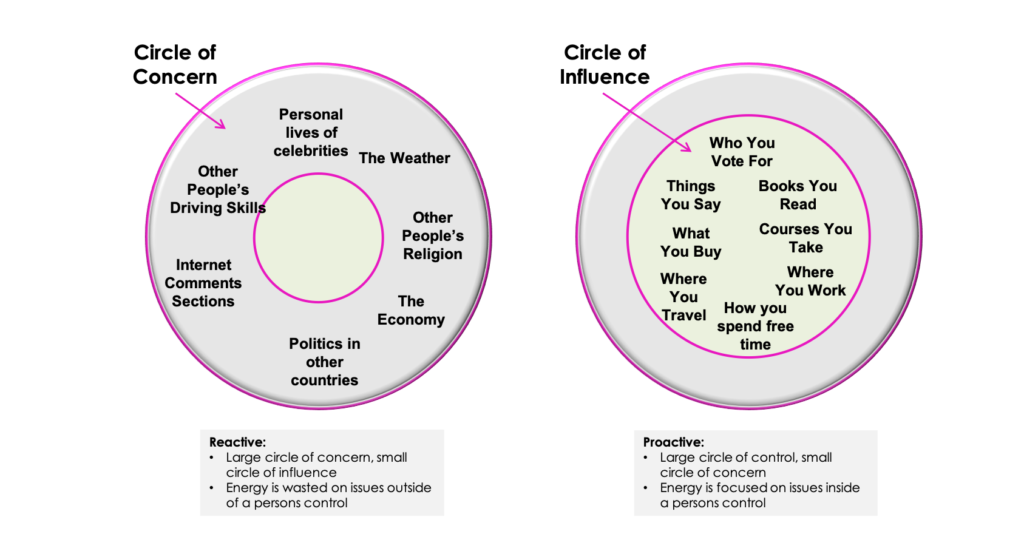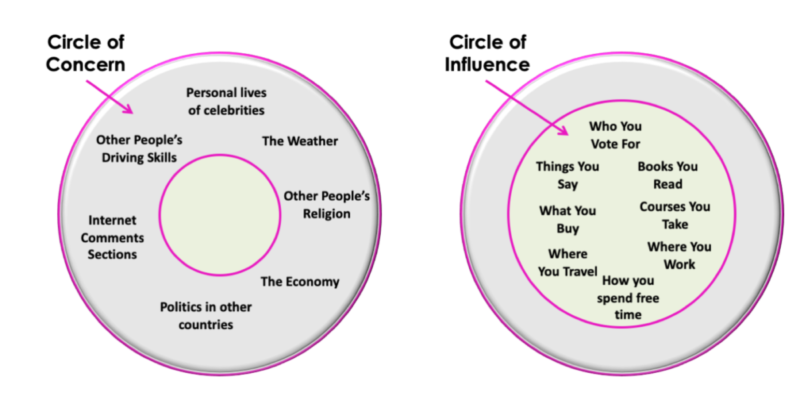Highly effective people do more than the average person. They accomplish their goals and broaden their influence, and over time, the scale of their accomplishments grow. Think of Jeff Bezos selling books online, Richard Branson opening a small record shop or Oprah Winfrey working for the local news. These people worked long hours to be sure, but so do a lot of people.
The difference is that these people focused their efforts on the right things at the right times. These people often cite how intensely focused they were on their ventures, particularly early on.
How can we replicate that in our own lives when so many things are pulling at us for attention? These people use a variety of tools to help them identify their priorities and focus their efforts. In this article, I’ll show you how to use a popular prioritization tool among highly effective people, the Circle of Influence.
Start with a proactive mindset
Highly effective people have a proactive mindset (as opposed to a reactive mindset), and the way you spend your time indicates whether you are a proactive person or a reactive person.
Proactive people focus as much of their energy as possible on issues that are in their control. When they do this, they create positive energy and their influence grows to include things were previously out of their control.
- Examples: what you read, the courses you take, what you buy, how you spend your free time.
Reactive people tend to neglect issues that are within their control and focus a lot of their energy on issues that are outside of their control. This causes influence to shrink.
- Examples: the weather, politics, celebrities, our favorite sports teams, other peoples’ actions.
Re-program your mind
Before we begin plotting out ways to accomplish more, we need to get comfortable taking a proactive mindset. If you grew up in a blue-collar working-class family as I did, then you may need to shift your paradigm. This can be hard. For instance, many of us were taught to get a practical education that leads to a secure job with benefits so we can retire comfortably at 65 years old. We were taught that if we show up and work hard every day then the opportunities for growth will come to us. If you do this, you are accepting the current reality, expecting it to unfold a certain way and then waiting for opportunities to arise, presumably at which point you will pounce. This is reactive.
But what happens when things change? Consider the unemployed automotive workers whose families had worked in factories for multiple generations, earning enough money to buy a home and raise a family? What happened to those people whose parents and grandparents encouraged them to put their eggs in that stable basket, only to have the entire basket disassembled. Many of these folks had no backup plan and weren’t prepared to adapt to a new economic reality. That’s one industry among many formerly stable and lucrative industries that have permanently changed or disappeared completely.
However, there are people in our workplaces thinking proactively, plotting out their moves and making strategic decisions to advance their careers. If we wait for the opportunities to come to us, we are going to get passed over again and again by proactive people who are developing the right skills, growing their influence and controlling their destinies. They are considering the future of their industries, managing their risks, developing relevant and transferable skills, and making a plan B, a plan C, a plan D, and so on…
Widen your scope with complementary skills
The threat of an entire industry shutting down isn’t scary to a proactive person, because they’re ready for it. Think of an automotive worker who takes night classes in finance or an oil-field worker who saves their money and studies real-estate investing. These folks are proactive, and by developing these skills, they’re putting themselves in a stronger and safer position. That automotive worker with the finance skills might become a highly-paid consultant in the automotive industry, or if the industry collapses, they can work at a bank. The oil-field worker can supplement their salary with rental property income, or if the industry collapses, they can become a full-time real estate investor.
You’ve found yourself here, reading this article. That means that you’re thinking about the future and looking for ways to accomplishing more, grow your influence and achieve big things; this is an example of proactive behaviour by a proactive person. So congratulations! Just by being here, you’ve already done the hardest part.
So What is the Circle of Influence Exercise?
Stephen Covey introduced the concept of the Circle of Influence and Circle of Concern in his book ‘The Seven Habits of Highly Effective People’.
The Circle of Influence is popular because it helps people to easily separate that which they can control from that they cannot. Within a few minutes, a person can get a good idea of how they can use their time more effectively.
In the image below, you can see that the Circle of Concern is the area that you have no control over, while the Circle of Influence is the area that you do have control over.

A person’s Circle of Influence almost always starts smaller than their Circle of Concern. There are so many things we can’t control, yet we expend a lot of energy and time on them. But with time and consistent effort, you can grow your influence to include concerns which you previously had no influence over.
Additional benefits:
The Circle of Influence exercise helps reduce energy spent on the Circle of Concern, which is a great benefit on its own; and yet there are many other benefits. For example, this exercise can:
- Help a project team to define the scope of their project.
- Boost your confidence as you find that you have more influence than you originally thought.
- Bring relief and reduce stress as you acknowledge and let go of issues that are out of your control.
- Help you set good goals that are entirely in your control.
Everyone has 24 hrs, so how do some people do so much more? They focus on the things they control. You can too, by cutting the time you spend on other peoples’ #business (celebrities, gossip, sports) and focusing on your own (creation, education, relationships).
— Chris (@ChrisjBergen) February 21, 2020
Start today🚀
How to do a Circle of Influence Exercise
Step 1: Make a list of concerns
As an individual or as a group, make a list of all the things that take up your time and energy in a day. This is like a brainstorming exercise, there’s no shame to be had and there are no wrong answers; just write whatever comes to mind.
If you are doing this as a group, I recommend that each team member have a pad of post-it notes. They should write each concern they can think of on a post-it note and stick it to a wall or a whiteboard. Be sure to set a time limit for this part of the activity.
If you are doing this exercise as an individual, then a list on a piece of paper will suffice.
- As an individual, you’ll want to consider things like the kinds of books and articles you read, your hobbies and interests, and the things that bother you and how you react (eg do you spend time debating with people online, leaving angry notes or writing product reviews? Put them on the list!).
- As a team, you’ll want to consider things like your competitors, customers, the market, other departments, meetings, KPI’s, and so on.
Step 2: Complete your circles
Draw a large circle, with a smaller circle inside of it. The inner-circle will be your Circle of Influence, and the outer ring will be your Circle of Concern(like the picture above). As a group, you should use a whiteboard or a large piece of paper. As an individual, a regular-sized piece of loose-leaf paper will suffice.
- As an individual, review each concern you’ve written and consider whether you can influence it. Then, re-write each concern in its appropriate circle.
- As a group, assign a volunteer to read the post-its to the group, have a quick discussion to decide whether the group has influence or not, and sort the post-its into their appropriate circles. If the group has trouble reaching a consensus, hold a vote. Carry on until all post-its have been sorted. Discard any duplicate topics (there will likely be many).
Step 3: Grow your influence
As a team or as an individual, consider what changes you should make based on what you have discovered and plan your next steps. Are there some concerns that you ought to give more attention, or concerns that you ought to neglect?
Are there concerns that are out of your influence that you would like to gain influence over? Consider what steps you might take to grow your influence over them (think of Amazon gaining influence over logistics businesses or ExxonMobil gaining influence over government policy decisions).
- Tip:Try and promote creative thought with a brainstorming activity, prompts or by calling on quiet group members.
Come up with at least one thing you can you do today to expand your Circle of Influence and build more positive energy. For example, you may not be able to cancel a recurring organizational meeting, but maybe you can get more out of them. Perhaps you can contribute to the agenda or listen for opportunities to connect with other work-areas.
- Tip: Try and promote creative thought with a brainstorming activity, prompts or by calling on quiet group members.
Step 4: Follow-up
Growing your Circle of Influence will be a continuous and gradual process and you’ll need to tinker often.
I recommend that you hang your circles in your meeting room or office, and refer to them whenever you’re defining goals or the scope for a project.
Set a date to re-evaluate your circles (not too soon — try quarterly, tri or bi-annually). Hopefully, your Circle of Influence will have grown and your Circle of Concern will have shrunk as a result of the goals you’ve achieved and the ineffective behaviours that you’ve shed since your last review.
Final Thoughts
This exercise requires soul-searching and you’ll need to be honest with yourself. The Circle of Influence is all about letting go of things, and it can be hard to let go of something you’ve invested a lot of time and energy into.
But know this: there’s no shame in admitting that you’ve been wasting time. We all waste time and that’s why we’re doing this exercise. I expect that many people (myself included) will find new items to remove from their circles in each successive review.
It’s hard to take yourself out of your body and look at yourself or your team objectively, but you’ll get better through practice and honest reflection. In the meantime, be proud and excited to admit when you find opportunities to be more productive, that’s real proactive behaviour.
Good luck, and thanks for reading!




